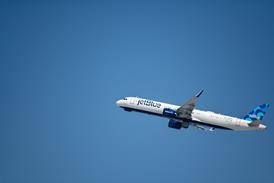Honeywell's Enhanced Ground Proximity Warning System (EGPWS) creator Don Bateman does not dispute the UK Civil Aviation Authority's recent finding that UK crews can expect to experience about 26 terrain awareness and warning system (TAWS) alerts per million flights. In fact, a Honeywell analysis of data from 500,000 flights of large commercial aircraft in 2005 indicates as many as 60 EGPWS warnings per million departures might be expected. About 95% of the world's airlines use Honeywell's product for their TAWS.
The UK regulator is concerned that terrain warning systems' false alarms, which it said occur seven times more frequently than genuine warnings, could potentially lead crews to react more slowly to an actual alert, decreasing the reaction time and hence the margin of safety designed into the equipment.
Those fears could be premature - Bateman says the false alarm problem is largely fixable with solutions that are already available.

Bateman contends that about two-thirds of the unwanted warnings are typically caused by database errors, a problem Honeywell addresses by updating its terrain, airport and obstacle databases three times a year. The company provides the materials free of charge to EGPWS owners. Bateman says the database-related warning rates are lowest in North America and western Europe where the terrain-runway-obstacle database has been continuously improved over the past 10 years and is "relatively mature".
Another key preventative is a free EGPWS software upgrade that reduces false alarms caused by noise-related GPS anomalies and extends the "floor" of the protected airspace from 1nm (1.85km) from the runway end previously down to 0.25nm, among other enhancements. Interest in the software enhancement has grown after revelations that a Mexicana Airlines Airbus A319 without the upgrade clipped power lines 0.6nm from the runway on descent into the Zacatecas airport in Mexico in late September. The crew did not receive an alert.
In addition to updating the software, Bateman says operators who are using GPS as the position sensor for their EGPWS and who have enabled "geometric altitude" have "significantly" fewer unwanted warnings, particularly in eastern Europe and Russia where "QFE" procedures (setting the altimeter to read zero altitude when on the runway, regardless of the runway's elevation above sea level) are still in use. Using geometric altitude, says Bateman, ensures that the EGPWS is independent of pressure or temperature altimetry errors. False warnings can be also caused by faulty aircraft sensors such as an erratic radio altimeter, he adds.
Although the relative rate of EPGWS alerts is low compared to other warnings according to the Honeywell analysis (see figure), even one false alert is one too many. "It hurts us, the credibility of the warning," Bateman says.
Showing off his spartan office at the company's Redmond, Washington site, next to Microsoft's sprawling metropolis, Bateman smiles when he picks up his "easy" button, a gadget made famous by office supply company Staples. While it might be a gimmick, the easy button is an appropriate metaphor for Bateman's lifelong endeavour to help pilots give everyone a safer ride.
Source: Flight International























